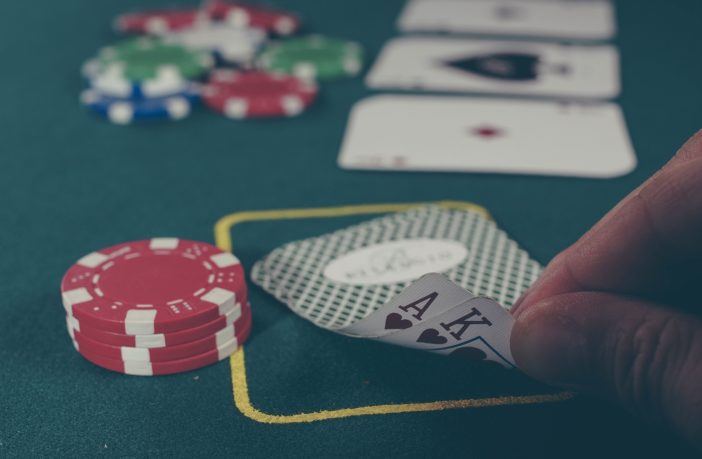Have you ever longed to say “Hit me!” at a high-stakes blackjack table but were too embarrassed to admit you don’t know the rules?
If so, this is the article for you!
Blackjack has been around for centuries. And is one of the most popular casino games. The basis of the game is simple: highest hand without going over 21 wins.
This simple game offers you the best casino odds. But it’s complicated when you get down to the nitty-gritty of playing.
Are you ready to get started? Here is our beginner’s guide to blackjack.
Your Invitation to the Best Online Pokies in Australia
Like a punt on the slot machines?
Our top rated slots for October 2019 are the smash-hit online pokie sites: Ruby Fortune and Jackpot City Casino.
These sites include some impressive matched bonuses – up to $750 and $1600 respectively! With the potential for some seriously big wins, here’s your chance to get a piece of the action:
The Basics: How to Play Blackjack
The object of blackjack is always to beat the dealer.
In a perfect hand, you do this by collecting a score of 21 on your first two cards. Of course, that doesn’t always happen.
The term “blackjack” gets thrown around as a score of 21 on any hand. That’s technically not true.
Blackjack is only made when you have a score of 21 on your first two cards. Scoring 21 later in the hand does usually result in a win, but it is not called blackjack.
Here are the ways you can win:
- Score 21 with your first two cards (blackjack), as long as the dealer doesn’t have a blackjack too
- Score higher than the dealer without going over 21 by adding to your hand later in the round
- Get the dealer to play until they go over 21 and you have not
There may be several players at your table. But you are still only playing against the dealer.
Card Values
Card values apply to all suits. Cards 2-9 are face value. Example: If you’re dealt a 2 and a 9, then your hand has a score of 11.
Cards 10, J, Q, and K are all valued at 10. Example: If you’re dealt a 2 and a Q, then your hand has a score of 12.
The Ace (A) is trickier because it can have two values. A is worth either 1 point or 11 points, depending on the other cards in your hand.
Example: If you’re dealt a Q and an A, then you have a blackjack with a score of 21. If you’re dealt a Q and a 2, then your score is 12.
If you ask for a hit, meaning the dealer deals you one more card, and it’s an A, then it is worth 1 point. Now your score is 13. Because if the card’s worth 11, you’d bust and be out of the hand.
The joker is never used in blackjack.
Decks
Standard blackjack uses a 52-card deck.
When you sit down to play, whether online or in person, notice the number of decks used. It should state this somewhere at the table or in the casino.
Why would the number of decks matter? Casinos implemented rules about decks when card counting became a problem.
Card counting is a strategy where a player keeps track of already dealt cards. This allows the player to bet more when the count is in their favour.
The act of card counting is not illegal as long as you don’t use a counting device or another person to count. But it is frowned upon by casinos and should not be your strategy. Gamblers are regularly thrown out of casinos for this practice.
To protect against this, casinos use multiple decks. The more decks used at a table, the better the odds are for the house. Many casinos offer better payout when you play at a table with multiple decks versus a table with only one deck.
For the sake of your own strategy, be aware of how many decks the dealer has before you begin. And always pay attention to the payout. We’ll talk more about this later.
Let the Game Begin
Every blackjack table has a low and high bet. Before the dealer deals, you make your bet based on the rules of the table. You place your bet by sliding the chips you plan to wager toward the centre of the table.
When everyone has made their bet, the dealer deals two cards, face-up to each player. The dealer also receives two cards. One face up and one face down.
If the dealer’s face-up card is an A or has a value of 10, the dealer will then check the face-down card to see if he has blackjack. If the face-up card is any other value, he won’t look at his face-down card until it is his turn to play.
If you and the dealer both have blackjack, it’s considered a draw and you keep your bet. If the dealer has a blackjack and you do not, you lose your bet.
If you have a blackjack and the dealer does not, you win the bet with the dealer and receive your payout. And if nobody has a blackjack with the first two cards, the game continues.
Payout depends on the type of table you’re playing. A common payout is 3:2. This means that for every $2 you bet, you’ll get $3 in return. This ratio gives the house slightly better odds.
Beware of riskier payouts like 6:5. These tables favour the house. This is often the payout ratio when the table uses only one deck.
If the hand is still live after the first two cards, it’s time to work on your strategy.
Blackjack Strategies
Blackjack is a game of numbers and much of your strategy depends on what numbers you’ve got. But pretty much every casino offers these options for players as their next move.
Hit
When you hit, you request another card from the dealer. The table etiquette for hitting is to tap the two cards with your finger.
Stand
This means you want to stick with the two cards you have. Signify a stand by waving your hand horizontally above the cards, left to right.
Double Down
If you are confident after the first deal that you’ll beat the dealer, you have this option. Double your original bet by placing extra chips next to your original bet and hold up a finger.
Split
If you get a matching pair, you have the option to split. This means you split your hand into two hands and play each individually.
To split, place your extra bet next to your original bet. Then hold up two fingers, indicating the split.
When to Hit and When to Stand
Before playing, you should learn a blackjack chart. These charts give you the greatest chance for success.
For example, if the dealer deals you a 2 and an 8, your hand total is 10. That’s too low.
You’ll want to hit in that situation. If you hit and get a 9, then your hand totals 19.
A hand of 19 has good odds of beating the dealer. So you’d want to stand after that card. You never want to go over 21 because that means you bust and lose your bet.
The Dealer’s Strategy
The house may have the advantage, but you do have one advantage over the dealer: you know how the dealer is going to play. Let’s explain.
The dealer always plays with the same set of guidelines. You can play however you like but dealers never deviate from the following rules:
1. The dealer always hits with a score of 16 or less.
2. The dealer always stands with a score of 17 or more.
Those two simple rules help you determine how you want to play. And it gives you a good idea of what the dealer has as his down card if he continues to hit or opts to stand.
Strategy: Tips for Success
As a beginner, learn the basics of the game and memorize a good chart. Gambling is about taking risks, but you can minimize your risk by following the basics. As you become more accomplished, you can take more risks based on your playing experience.
Never play a table that has 6:5 payout. This gives the casino much higher odds. Stick to 3:2 payouts for the best chances to win.
Keep your emotions in check. Remember, it’s not the dealer’s fault that you’re losing. Never be rude or you’ll find yourself out on the curb.
And keep your emotions out of your wagers too. Getting too excited can cost you a ton of money if you’re not careful.
And while we’re at it, keep your alcohol consumption in check too. Serious poker play is no time to be drunk. Follow this simple rule: the more you drink, the more money you’ll lose.
Play Blackjack Like a Rockstar
Think blackjack is an easy game? Think again. Blackjack takes skill and practice.
But it can also be one of the most fun games to play. Learn the basics, practice proper etiquette, and keep your emotions under control.
This beginner’s guide to blackjack is a good starting point. There are more advanced moves and plays that you can learn once you’ve mastered the basics. The more information you have, the better your odds.
Click here for the best and worst odds in Australia’s favourite casino games.




